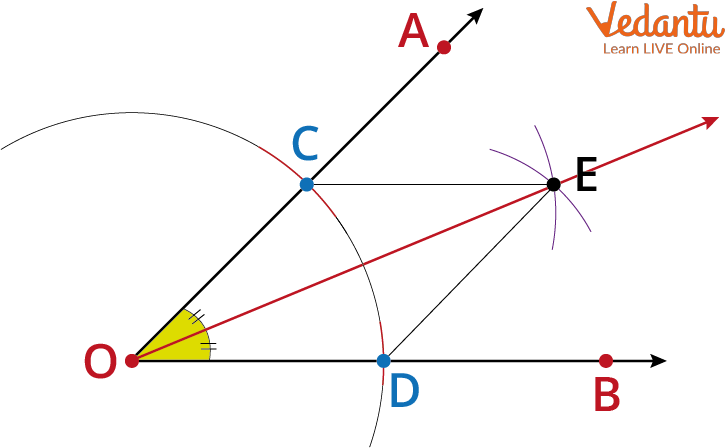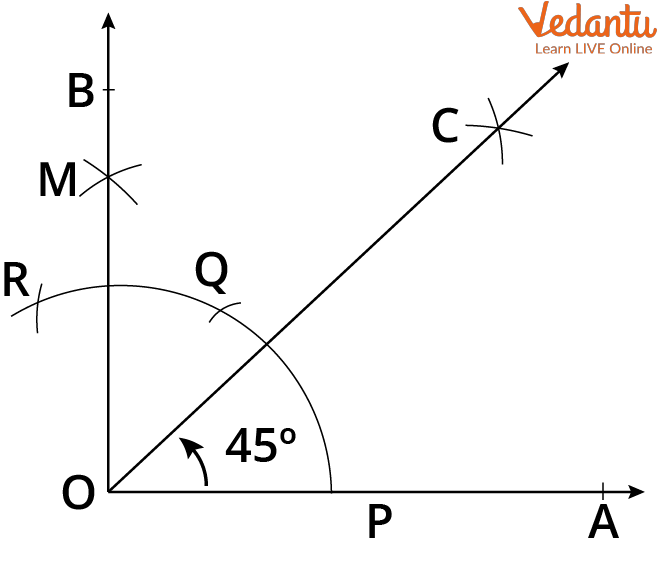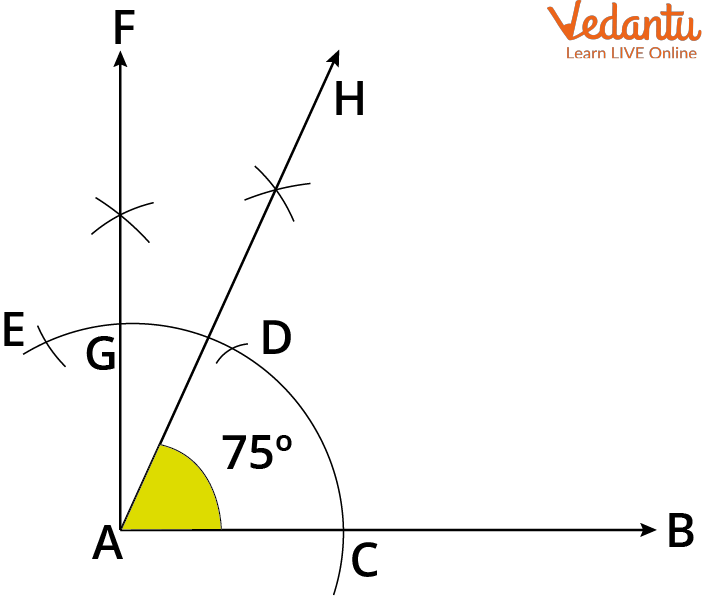




Introduction of Construction of Angles
Angles are everywhere in geometry problems. This article will teach you how to construct the angles you need for many different types of geometric problems. construction of angles is everywhere in geometry problems. this article will teach you how to construct the angles you need for many different types of geometric
Construction of Vertical Angles
A vertical line is a line that is perpendicular (At a right angle) to the horizontal level ground. If you have two lines on the same plane intersecting, you draw a diagonal of one line to the other. If they intersect perpendicularly, the lines form vertical angles on each side of the points of intersection.
Construction of Supplementary Angles
Constructing the angle of a line going through 90 degrees is easy if you know how to construct perpendicular lines. If two lines intersect creating a "T" shape, you draw two lines from the top of one line to the bottom of the other. The angles formed are supplementary.
Construction - Step by Step Representation
Construction of an angle can be broken down into a couple of steps:
1) Draw a ray, and
2) draw a line perpendicular to that ray. Then, set your compass point at the vertex of the angle you want to draw and extend its legs so they cross one another.
Use those intersection points as the centre of your circle, and construct your angle. It can be helpful to use a ruler for this, but if you do it correctly the compass should already be in the right place. With the help of the construction of any angle, you will be able to solve problems in geometry.
Constructing 30, 60, 90, 120 Degree Angles
One of the most important aspects of geometry is constructing angles. Understanding the basics of this is very important and thus one must try and learn this properly.
1. Constructing a 60 - Degree Angle:
In an equilateral triangle, all the angles are equal and they are equal to 60° in size. Thus, to draw 60°, we need to construct an equilateral triangle.
Step 1: Draw the arm PQ.
Step 2: Then place the point of the compass at P and draw an arc such that it passes through Q.
Step 3: Now place the point of the compass at Q and draw an arc such that it passes through P. The arc drawn at this step should cut the arc drawn in the above step at R.
Step 4: Now joining P to R. This angle measures 60° as the triangle PQR formed is equilateral.
2. Constructing a 30° Angle:
We know that 30° is half of 60°. So we can apply this knowledge to construct a 30° angle.
Step 1: To construct an angle of 30°, we first need to construct an angle of 60° and then further bisect it.
Step 2: Draw the arm PQ
Step 3: Then place the point of the compass and then draw an arc that passes through Q.
Step 4: Place the point of the compass at Q and then draw the arc which cuts the arc drawn at the above step at another point R.
Step 5: With the compass at Q, draw another arc near the point T as shown in the figure.
Step 6: Now with the point of the compass at R, draw another arc to cut the arc drawn at step 5 at T.
Step 7: Now join the point T to the point P. Now the angle QPT is 30°
3. Constructing a 120° Angle:
120° angle can be constructed using the logic that 60° + 120° = 180°. Thus, we can understand that to construct 120° we can construct 60° angle and then further extend one of its arms as shown below in the figure.
4. Constructing a 90° Angle:
To construct a 90° angle, there are two ways. The first one is by bisecting a straight angle and the other step is given below.
Step 1: First draw the arm PA.
Step 2: Now place the point of the compass at P and then draw an arc that cuts the arm at Q.
Step 3: Now place the point of the compass at Q and draw an arc that has a radius similar to the radius of PQ. This arc must cut the arc which is drawn in the above step at a point R.
Step 4: Now place the point of the compass at R and draw an arc of the radius which is similar to the radius of PQ to cut the arc which is drawn at step 2 at another point S.
Step 5: With the point of the compass at R, draw another arc of radius the same as the radius of PQ near the point T as shown in the figure below.
Step 6: With the point of the compass at S, draw an arc of radius similar to the radius of arc PQ and cut the arc which was drawn at step 5 at the point T.
Step 7: Join T to P using a scale. The angle APT formed measures 90°.
Constructing Angle Bisectors
By making angle bisectors for an angle, one can divide the angle precisely in half. A bisector divides an angle into two equally sized parts. Angle bisector construction results in a line that provides two congruent angles for a given angle. For instance, when an angle bisector is built for a
Compass Use to Construct an Angle Bisector
A line that divides an angle into two equal halves is known as an angle bisector. If the angle's measurement is known, we just need a protractor, a ruler, a pencil, and a math compass to construct an angle bisector geometrically. An angle bisector can divide any angle into two equal parts. Let's think about the angle AOB displayed below.
Keep in mind that the angle's magnitude is not specified here. Therefore, we can construct the angle bisector without using a protractor.
To create an angle bisector, follow the procedure given below:
Draw two arcs with O as the centre, spanning any radius width, so they intersect the rays OA and OB at places C and D, respectively. Since these are the radii of the same circle, OC = OD.
Draw two arcs with centres at C and D so that they connect at a place called E while maintaining the same distance between the compass's legs (in the image).

Angle Bisector
Because the two arcs drawn in this phase have the same radius, take note that CE = DE.
Join the Ray OE. This is the necessary angle bisector of angle AOD.
Construction of Angles
Let's practise making angles with a ruler and compass. In the methods below, we will first create a
Sketch an AB ray.
Draw a semicircular arc that touches the line segment AB and label it Q using A as the centre and any width as the radius.
Draw another arc with Q as its centre and designate this point as D, but leave the radius unchanged.
Carry out the previous step with D as the centre and identify the drawn arc as E.
Now, create arcs that meet each other at a point and name it F, using the same radius and the centres E and D.
Finally, connect points A and F. This line, also known as the perpendicular line, forms a
Write P at the semicircular arc's intersection with the AF line.
Now, using the same radius as in step 2, draw two arcs with the centres P and Q. Identify R as the intersection of these arcs. Connect points A and R. Now, RAB and FAR are both

Angle
How to Construct an Angle of 75 Degrees?
The following are the steps to construct
Sketch an AB ray. Draw an arc with any radius that passes through A and AB at C.
We draw an arc with C as the centre and the same radius that cuts the first arc at D. We then create an arc with D as the centre and the same radius that cuts the first arc at E.
We draw two arcs with the same radius and centres at E and D intersecting at F. Draw a line AF. Line AF and line segment AB intersect at a
Mark the line AF's intersection with the semicircular arc as G in step 4. Draw two arcs again, cutting each other at H, using G and D as the centres. We now join AH. HAB is
The following diagram illustrates how to draw 75-degree angle with a compass.

75 Degree Angle
Example Problem
1. Use a ruler and compass and construct a triangle ABC. in the triangle, AB = 5 cm, angle BAC = 60° and AC = 4.5 cm. Also, measure the angle of angle ABC and angle ACB and calculate the angle sum of ABC.
Solution
Step 1: First draw the line AB which is 6m long.
Step 2: Now use a compass to construct a 60° angle at point A.
Step 3: Use the ruler to find C such that AC is 4.5 cm long.
Step 4: Now, join B to C.
The triangle ABC formed is the required triangle.
Now, for the next part, we can use a protractor to find the rest of the angles.
Thus we can conclude that,
Angle ABC = 55°
Angle ACB = 65°
Thus, the angle sum of the triangle ABC = 60° + 55° + 65° = 180°
Conclusion
This article has shown you how to construct many different angles. Angle construction is what you need to complete many geometry problems. This article provides the steps needed to construct any angle you might find in geometry. construction is a very useful tool in mathematics. It is what you need to complete many geometry problems.
This article provides the steps needed to construct any angle you might find in geometry. Construction is a very useful tool in mathematics. With the help of the construction of angles, students can solve any question related to the construction of angles and score very good marks in examinations.
FAQs on Construction of Angles
1. How can I construct an angle when given three points?
Constructing with only two points is easy because the angles formed will always be inside the two points. If you are given three points on a circle, draw an arc connecting them and cut off segments equal to each of the angles. You can then bisect the angles to get your angles. Constructing an angle of three points is very difficult. students can solve the problem by using their knowledge and the steps presented in this article. The construction of a triangle helps them a lot to find the angles of a triangle.
2. How to use the concept of construction of angles to solve problems?
This is an easy question because using construction is simple. When you are given two angles and a side, draw the angle two times (giving the third angle their sum). Then bisect the given angle and its extension to get the third line. This line will be perpendicular to the side that was given. If you are given three angles and a side, draw the third angle which is the sum of the three angles. Draw lines that bisect their adjacent angles. These lines will be perpendicular to the given side. If you are given three points on a circle and aside, draw an arc connecting them and construct the angle which is the measure of the given side at their point.
3. What is the easiest way to construct an angle?
The easiest way to construct an angle is to divide it into two or smaller angles. If you are aware of the number of times you can take the given angle and divide it, you can quickly find the value. With the help of the easiest way, students can solve the problem. constructing an angle is a very useful tool in mathematics. With the help of this tool you can solve many problems and score good marks.
4. How to construct an angle when given one side and the measure of another?
To construct an angle when given one side and the measure of another, draw an arc that cuts off a segment equal to the given side. This arc will cut off a segment equal to the measure of the other side. Bisected the resulting angles and extend them until they cut off a whole arc on each side. These lines will be perpendicular to the given side and cut off a segment equal to the angle you want to construct. It's easy to construct an angle when given one side and the measure of another. With the help of this easy method, you can score good marks in your exams.
5. How to construct an angle if I am given a point and the measure of another?
To construct an angle if given a point and the measure of another, draw an arc that cuts off a segment equal to the given side. Bisect the two resulting angles and extend them until they cut off a whole arc on each side. These lines will be perpendicular to the given side and cut off a segment equal to the angle you want to construct. It is very easy to construct an angle when given a point and the measure of another. With the help of this simple method, you can solve many problems and get good marks in your exams.
6. How will you construct an angle of
Construction of an angle
Take any OA ray.
Draw an arc with O as the centre and any practical radius that cuts OA at B.
Draw the first arc at C, with B as the centre and the same radius.
Cut an arc at D, using C as the centre and the same radius as before.
Draw two arcs that cross at E and merge at OE, with C and D as the centre and radius of more than half of CD.











